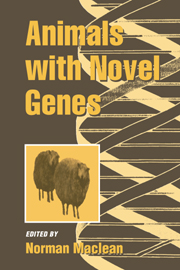4 - Transgenic birds
Published online by Cambridge University Press: 21 October 2009
Summary
Introduction
Birds are virtually unique among domesticated species in being bred for the nutrient value of their ova, and few organisms have been subjected to as much genetic selection as poultry. These two features encapsulate both the attractions and the frustrations of producing transgenic birds.
Current breeding practices in the poultry industry depend on natural genetic variation that is exploited by selective reproduction. New variants are introduced from mutations or translocations, but there is a progressive loss of ‘wild-type’ characteristics. By inserting foreign DNA into organisms it is possible to bypass reproductive barriers and induce gene flow between vastly different organisms from quite distinct populations. Thus, the potential benefits of genetic engineering are extremely attractive, for they could dramatically increase both the genetic repertoire and the rate of change of a particular breed. Unfortunately, one of the characteristics of birds that makes them so commercially attractive – their large eggs – is also one of the features that makes it necessary to devise new approaches to their genetic engineering. The most common way of introducing foreign DNA into mammals is microinjection into the male pronucleus (Palmiter & Brinster 1986). The large size of birds' eggs makes it virtually impossible to see these structures and, to make matters worse, polyspermy is common. There may be up to 20 male pronuclei in a fertilized fowl egg with no indication as to which will eventually fuse with the female pronucleus.
- Type
- Chapter
- Information
- Animals with Novel Genes , pp. 106 - 137Publisher: Cambridge University PressPrint publication year: 1995



